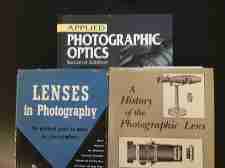Toronto. … with my little eye is a child’s game we once played in backyards, on streets, and on long boring drives to visit relatives. The game brought to my mind camera lenses. Browse the internet or the books shown at left to better understand lenses and lens design.
Calculations were tediously manual until the early 1950s when computers took over. One early firm to use computer calculations was E Leitz Canada (as I recall). Optics were once taught (sparingly) in university as part of a physics program.
The camera’s lens is often considered its ‘eye’ since it serves the same function: displaying the rays from the ‘subject’ on the sensitive media (film instead of retina) . When the Daguerreotype process was announced in 1839, the camera used by Daguerre had an f/19 meniscus lens for use with the abysmally slow media. Initially it took minutes of bright sunlight to record the ‘subject’.
This less than stellar performance resulted in a contest to produce the best (fastest) portrait lens. Petzval won in 1840 with his f/3.6 portrait lens which was first made by Voigtlander. And the races was on!
As time passed, the size of the sensitive media fell; the sensitivity of the media increased; and lens quality improved. Each photographic lens was composed of a series of glass element, with varying curves and refractive indices. Every element was a segment of a sphere.
Two main kinds of glass were first used – crown and flint. Years later, small glass firms like Otto Schott (who later joined the Zeiss organization) added ingredients that would provide customized refractive indicies immensely aiding lens design. For many years, various lens types became popular.
Before electronic computers, mathematicians patiently drew light rays through a lens to predict its performance. The objective of the elements was to reduce distortion; cover the media; and create a flat(ish) plane at the media for two visual colour bands (achromat) and later three (apochromat).
Before WW2, the lenses were uncoated and light rays reflected off each element reducing the contrast of the scene and limiting the practical number of elements. After WW2, element coatings became common. The coatings improved the scene’s contrast while allowing more elements to be used. By mid last century so called zoom lenses began to appear allowing for a variation in focal length without a lens change.
In the last 4 or 5 decades of the film era, aspheric elements were added to the mix to improve lens performance and reduce the number of elements needed – at a rather expensive price point.
Entering the digital era, cameras sometime used well established brand name lenses such as Leitz or Zeiss (I have an older Sony with a Zeiss zoom lens). Today, well into the digital era, the brand of lens seems of little interest as smartphones are routinely made using (generally unknown to us) camera modules. The phones also use miniature computers to modify (improve) images making the tiny sensor in each camera module practical once again.
Visit our 2025 events to find lenses and other goodies for your collection. Next up we are holding our famous fall fair on October 19th – see the JULY newsletter issue 25-7 for details.









